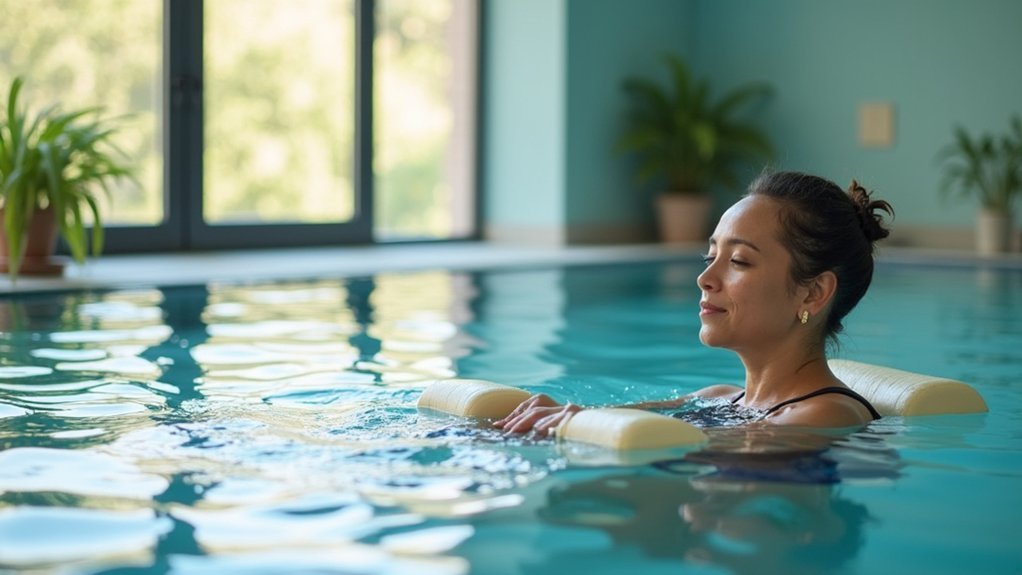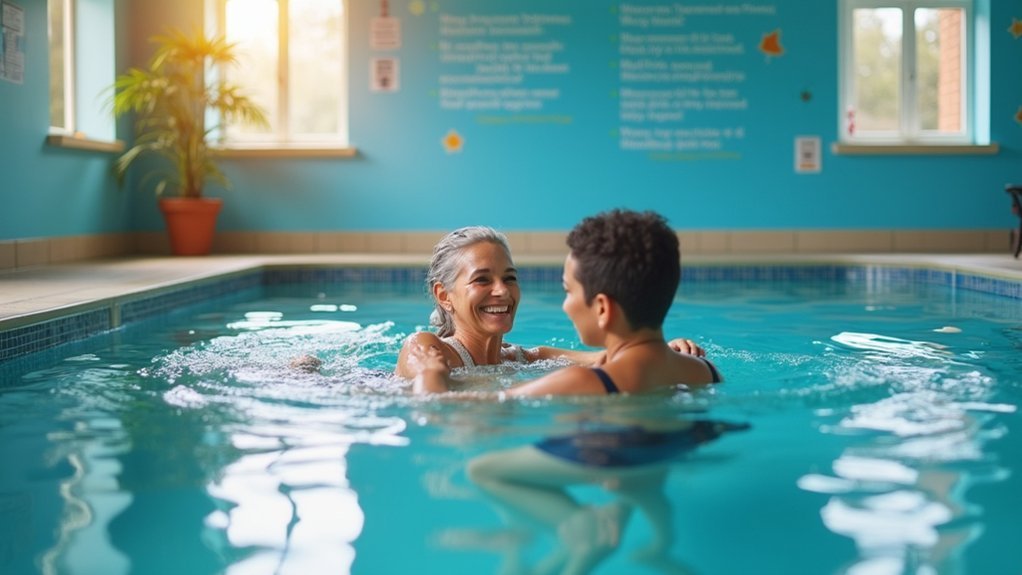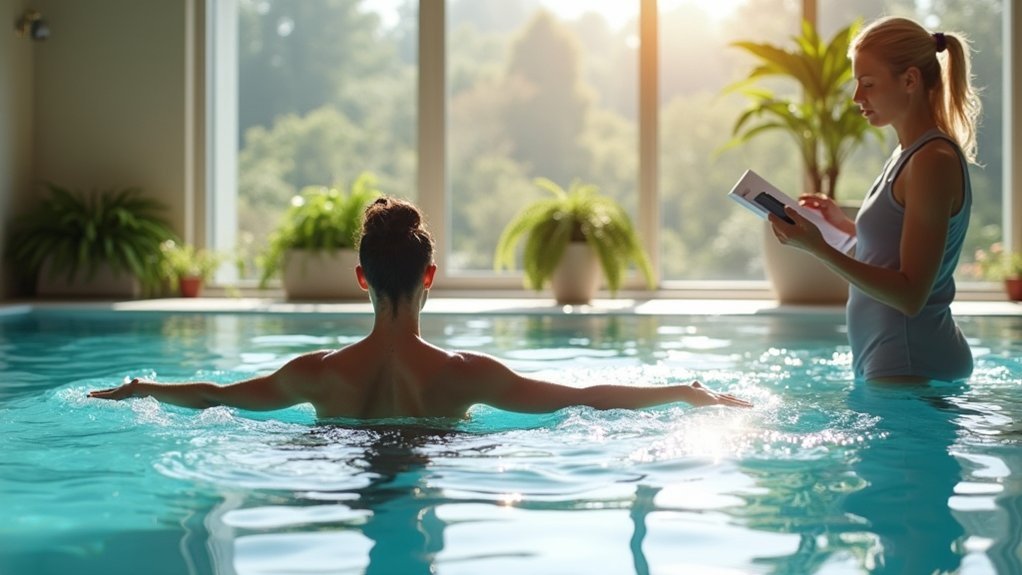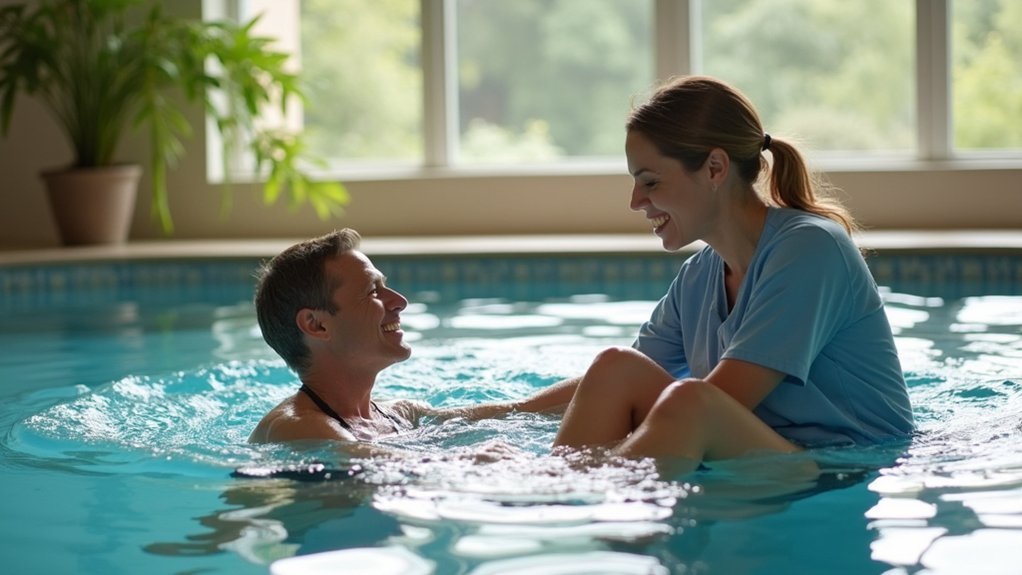Aquatic therapy relieves pain through multiple mechanisms working together. You’ll benefit from buoyancy reducing joint pressure by up to 90%, while warm water (32-34°C) relaxes muscles and boosts circulation. Hydrostatic pressure acts like compression therapy, decreasing inflammation and dulling nerve endings. Water’s resistance strengthens muscles without jarring impacts, and its calming environment reduces anxiety that amplifies pain. These combined effects create an ideal therapeutic space where healing can flourish.
The Science Behind Water’s Pain-Relieving Properties

While many people view water therapy as simply relaxing, the scientific principles behind aquatic therapy reveal why it’s so effective for pain management. When you’re immersed in water, buoyancy immediately reduces pressure on painful joints, allowing you to move without the constraints of gravity.
Hydrostatic pressure works as natural compression therapy, improving circulation while reducing inflammation and swelling in damaged tissues. This pressure surrounds your body evenly, enhancing lymphatic drainage and creating stability that promotes healing. Aquatic therapy provides a unique moment of weightlessness that creates comfort during the recovery process.
The gentle embrace of water’s natural pressure heals from all sides, creating a 360-degree therapy that your body instinctively responds to.
The thermal properties of warm water amplify these benefits by decreasing muscle tension and diminishing pain signals to your brain.
This combination of physical forces—buoyancy, resistance, pressure, and warmth—creates an ideal environment where you’ll experience pain relief while gradually rebuilding strength during rehabilitation exercises.
How Buoyancy Transforms Movement for Chronic Pain Patients
When chronic pain patients enter the water, they experience an almost immediate transformation in their movement capabilities. The water’s buoyancy counteracts about 90% of body weight, greatly relieving pressure on painful joints and muscles.
This weightlessness allows you to perform exercises that might be impossible on land. You’ll find yourself attempting movements you’d normally avoid due to pain, as the supportive environment reduces fear of discomfort.
The water’s gentle resistance strengthens muscles without jarring impacts, helping stabilize joints affected by conditions like osteoarthritis. For many individuals suffering from chronic pain conditions, aquatic therapy provides an effective alternative when traditional exercises are too painful to perform.
Warm water therapy also relaxes tense muscles, enhancing your range of motion and flexibility. Many patients report improved mobility after sessions, as they can safely practice functional movements like walking and squatting in this protective environment.
Warm Water Therapy: Temperature’s Role in Pain Management

The temperature of water in aquatic therapy plays a crucial role beyond simply providing a comfortable environment. Maintained at 32°C to 34°C, warm water helps relax tight muscles, reduces spasms, and increases blood circulation to injured tissues.
You’ll experience enhanced flexibility during movement, allowing for better range of motion during rehabilitation exercises. The 91 to 92 degrees temperature setting is specifically chosen for its therapeutic properties.
Warm water’s therapeutic benefits include:
- Stimulating endorphin release—your body’s natural pain relievers
- Decreasing pain signal transmission in your nervous system
- Improving tissue elasticity, reducing injury risk during therapy
- Enhancing overall comfort, which encourages greater participation in exercises
Research shows patients report markedly lower pain scores on the Visual Analog Scale when exercising in warm water compared to cooler environments, making it particularly effective for conditions like arthritis and fibromyalgia.
Hydrostatic Pressure: Nature’s Compression Therapy
Hydrostatic pressure serves as one of water’s most powerful therapeutic properties in pain management. When you’re immersed in water, this natural force exerts even pressure on your body that increases with depth, functioning like a built-in compression stocking.
This pressure reduces swelling and inflammation while improving circulation by pushing fluids through your vascular system. It dulls nerve endings, offering relief for conditions like fibromyalgia, chronic back pain, and CRPS.
You’ll benefit from enhanced respiratory function as the pressure against your chest wall increases lung capacity. In a supervised environment, licensed physical therapists guide patients through specialized exercises that maximize these hydrostatic benefits. For spine-related pain, deep water traction uses hydrostatic pressure to decompress vertebrae.
When combined with buoyancy and water’s thermal properties, you’ll experience extensive pain relief that’s difficult to replicate on land.
Psychological Benefits of Aquatic Environments on Pain Perception

Beyond the physical advantages, aquatic therapy offers profound psychological benefits that directly influence pain perception. When you’re immersed in water, the environment creates a sensory shift that can alter how you experience pain. The weightlessness sensation reduces both physical and mental burden, allowing your mind to process discomfort differently. Multiple studies in Hadley Faris’s systematic review demonstrated superior pain reduction with aquatic therapy compared to land-based alternatives.
- The calming nature of water decreases anxiety and stress, known amplifiers of pain.
- Warm water therapy promotes relaxation and improves sleep quality, essential factors in pain management.
- The non-threatening environment lets you attempt movements that might be painful on land.
- Accomplishing exercises in water builds psychological empowerment and resilience against pain.
This unique therapeutic setting transforms not just how you move, but how you perceive and respond to pain signals.
Comparing Land-Based vs. Water-Based Therapy Outcomes
When you exercise in water, you’ll encounter consistent resistance in all directions without the harsh impact that land-based activities impose on your joints.
Your body recovers more quickly after aquatic therapy sessions because water’s buoyancy reduces the strain on injured tissues while still providing effective strengthening.
Water-based rehabilitation typically shortens recovery timelines compared to traditional physical therapy, especially for those with severe joint pain or mobility limitations. Recent clinical studies demonstrated that aquatic therapy significantly decreased pain during activity for chronic low back pain patients compared to pre-treatment levels.
Resistance vs. Impact Factors
The fundamental difference between land-based and water-based therapy lies in how each environment affects the body during exercise.
In water, you’ll experience natural resistance without the harsh impact on your joints that occurs on land. This allows you to build strength while protecting sensitive areas from further damage. This is particularly beneficial for individuals with chronic low back pain, which affects approximately 7.5% of the global population.
- Water provides customizable resistance that increases with movement speed, eliminating the need for weights.
- Your perceived exertion level is typically lower in water, making exercises more tolerable despite considerable muscle engagement.
- The buoyancy effect reduces your body weight by up to 90%, greatly decreasing joint stress.
- Unlike land therapy where gravity constantly challenges stability, water supports your body while still requiring core activation.
Recovery Time Differences
Although both approaches offer unique benefits, aquatic therapy typically reduces recovery time compared to traditional land-based rehabilitation methods. The water’s buoyancy allows you to begin rehabilitation exercises earlier, reducing downtime and preventing muscle atrophy that’s common after surgery.
You’ll likely experience quicker pain relief in water, enabling smoother progression through early recovery stages. The warm water environment helps decrease pain and soreness during and after therapy sessions, making exercises more comfortable to perform. Hydrostatic pressure improves circulation, accelerating tissue repair, while the supportive environment enhances range of motion sooner than land-based therapy.
Research on ACL repairs and ligament injuries confirms these advantages, particularly during initial rehabilitation phases.
For best results, consider combining both approaches—aquatic therapy for early recovery and land-based methods for advanced strength training. This integrated strategy addresses both physical and psychological aspects of healing, potentially shortening your overall recovery timeline.
Aquatic Therapy Success Stories: Real Patient Experiences

Remarkable transformations occur daily in aquatic therapy pools across the country, where patients find relief from pain and limitations they once thought permanent.
Athletes like Rachel, a professional dancer, and Alex, a college basketball player, regained their mobility and returned to their passions through personalized aquatic regimens.
The water’s buoyancy creates an ideal environment for recovery across diverse situations:
- Marathon runners John and Sarah overcame chronic knee pain and IT band syndrome, with Sarah achieving a personal best time post-therapy.
- Mary, a stroke survivor, reclaimed her independence through supportive water exercises.
- Patients consistently report reduced pain levels and enhanced mobility.
- The psychological benefits include increased confidence and motivation during rehabilitation.
The therapeutic water temperature helps relax muscles and improve blood circulation, enhancing the overall healing process for chronic pain sufferers.
Adaptable Equipment for Enhanced Aquatic Pain Relief
Modern aquatic therapy environments leverage an impressive range of specialized equipment designed to maximize therapeutic benefits while minimizing pain.
You’ll find adaptable features like variable water depths and temperature controls that therapists can customize to your specific comfort needs.
Equipment such as swim bars and float systems provide essential support while underwater treadmills and bicycles offer resistance training without joint stress. Most facilities also stock aquatic jogger belts that provide buoyant support and proper body positioning during water exercises.
For targeted pain relief, massage jets deliver deep tissue therapy, while resistance paddles help build upper body strength.
The integration of moveable pool floors makes therapy accessible even if you have mobility challenges.
Many rehabilitation centers also utilize recording devices like underwater cameras to monitor your progress and refine your treatment plan.
These technological adaptations guarantee your aquatic therapy experience delivers peak pain relief results.
Specialized Water Exercises for Different Pain Conditions

You’ll find remarkable relief through joint-specific movement protocols tailored to your unique pain condition, whether you’re managing arthritis, fibromyalgia, or back issues.
These specialized exercises target affected areas with precise movements that minimize stress while maximizing therapeutic benefits. For example, individuals with osteoarthritis can benefit greatly from walking or jogging in water as it reduces pressure on painful joints.
As you gain strength and mobility, resistance progression techniques allow you to gradually increase intensity by adjusting your speed, adding water equipment, or moving to deeper water for continued improvement.
Joint-Specific Movement Protocols
While each joint in the body has unique structural and functional characteristics, aquatic therapy can be tailored with specific movement protocols to address distinct pain conditions. Your therapist will recommend exercises designed for your particular needs, leveraging water’s natural properties to facilitate healing.
- Spine Relief: Gentle water walking and floating exercises reduce load on your spine, effectively alleviating back pain.
- Hip Mobility: Targeted stretches and water aerobics strengthen muscles surrounding your hips, improving function and reducing discomfort. The warm water environment promotes muscle relaxation and enhanced circulation, making movement easier for patients with chronic hip conditions.
- Knee Rehabilitation: Simple leg lifts in water build strength without straining your knee joints.
- Upper Body Freedom: Arm circles and shoulder exercises increase mobility and decrease pain through the natural resistance of water.
Resistance Progression Techniques
As pain tolerance and mobility improve during aquatic therapy, introducing progressive resistance becomes essential for continued rehabilitation success. You’ll find that water’s natural resistance can be amplified through movement speed, position changes, and specialized equipment to target different pain conditions. Water’s density and viscosity provide natural resistance that can be leveraged for therapeutic benefit throughout the rehabilitation process.
The key to effective resistance progression lies in systematically increasing challenge while maintaining proper form and pain-free movement.
| Technique | Application | Benefit |
|---|---|---|
| Speed Variation | Increase movement velocity | Greater resistance without equipment |
| Surface Area | Add paddles or resistance gloves | Targeted muscle strengthening |
| Depth Adjustment | Move to shallower water | Reduced buoyancy, increased loading |
| Direction Changes | Multi-directional movements | Improves functional strength patterns |
| Progressive Equipment | Add foam dumbbells, ankle cuffs | Customized resistance for specific needs |
The Long-Term Benefits of Consistent Aquatic Therapy
When patients commit to regular aquatic therapy sessions, they often discover benefits that extend far beyond immediate pain relief.
Over time, you’ll experience significant reductions in chronic pain that can last up to 12 months after completing your program. The combination of buoyancy, resistance, and hydrostatic pressure works continuously to improve joint functionality and mobility. Research has shown that patients who undergo therapeutic aquatic exercise demonstrate greater improvements in pain, function, and quality of life compared to those receiving conventional physical therapy modalities.
- Enhanced pain management through muscle relaxation and improved sleep quality
- Increased joint flexibility and range of motion with reduced load on weight-bearing joints
- Psychological improvements including reduced anxiety, enhanced mood, and greater confidence in movement
- Progressive muscle strengthening without the risk of overexertion or inflammation
This holistic approach to recovery makes aquatic therapy particularly valuable for long-term pain management and rehabilitation.
Getting Started: Finding the Right Aquatic Program for Your Pain
When seeking an aquatic therapy program for pain management, you’ll need to carefully evaluate facility options for qualified therapists, appropriate water temperatures, and accessible equipment.
Your program should be customized to address your specific pain issues, mobility limitations, and therapeutic goals. It’s important to ensure that all open wounds are healed before beginning aquatic therapy sessions to prevent complications.
Start by consulting with your healthcare provider who can recommend facilities with expertise in your condition and help establish realistic expectations for your aquatic therapy journey.
Evaluating Facility Options
How do you find the right aquatic therapy facility when there are so many factors to contemplate?
When evaluating potential locations for your aquatic therapy, you’ll want to carefully assess both the physical environment and program structure to guarantee it meets your specific pain management needs.
Look for facilities that offer:
- Accessible pool entry with handrails and ramps if you have mobility challenges
- Proper water temperature and cleanliness for ideal therapeutic benefits
- Specialized equipment like flotation devices and resistance bands
- Flexible scheduling options that fit into your routine
The facility’s atmosphere matters too—a supportive, welcoming environment can greatly impact your motivation and rehabilitation experience. Working with licensed physical therapists who specialize in aquatic therapy ensures you’ll receive proper guidance and treatment tailored to your condition.
Don’t hesitate to visit locations beforehand to check their accessibility features and observe the overall environment before committing.
Customizing Your Program
Once you’ve selected a suitable facility, the next step is tailoring an aquatic therapy program specifically for your pain management needs. Your therapist will assess your mobility, strength, and pain levels to create personalized exercises that address your condition.
| Condition | Recommended Techniques | Benefits |
|---|---|---|
| Arthritis | Gentle joint movements | Reduced inflammation |
| Fibromyalgia | Warm water exercises | Muscle relaxation |
| Post-surgery | Controlled resistance | Accelerated healing |
| Back pain | Deep water therapy | Spinal decompression |
| Limited mobility | Underwater treadmill | Improved gait patterns |
The customization process guarantees you’re getting maximum benefit with minimal discomfort. Your program should evolve as you progress, with adjustments to resistance, duration, and complexity. Water’s natural properties allow for exercises that might be impossible on land, making it ideal for rebuilding strength gradually while managing pain effectively. After examination, your physical therapist may implement a combination of aquatic and land-based therapies to maximize your rehabilitation potential and provide comprehensive treatment.
Research-Backed Evidence for Aquatic Therapy’s Effectiveness
Scientific research strongly supports aquatic therapy as an effective intervention for multiple pain conditions.
Studies have demonstrated that water’s buoyancy creates an ideal environment for rehabilitation, showing significant improvements in pain reduction and functional mobility when compared to traditional therapies.
The therapeutic properties of water provide a superior rehabilitation setting for enhanced pain relief and mobility outcomes versus standard treatment approaches.
- Clinical trials confirm aquatic therapy reduces joint pain and improves mobility in osteoarthritis patients with minimal discomfort.
- Research shows hydrostatic pressure accelerates muscle recovery by decreasing inflammation and improving circulation.
- Post-surgical patients experience quicker rehabilitation and less muscle atrophy through early water-based exercises.
- Studies validate improved balance and coordination in older adults, with accompanying psychological benefits including reduced anxiety and improved confidence.
Water’s natural properties create a stress-free environment that enhances the therapeutic experience while simultaneously promoting physical healing.
You’ll find that evidence-based research consistently demonstrates aquatic therapy’s effectiveness across various conditions, making it a reliable option for your pain management strategy.
Frequently Asked Questions
Is Aquatic Therapy Covered by Most Insurance Plans?
Yes, your insurance will likely cover aquatic therapy when it’s performed by licensed physical therapists. You’ll need to guarantee it’s prescribed as medically necessary rehabilitation rather than general water exercise classes.
How Do Chlorine and Pool Chemicals Affect Skin Conditions?
Chlorine can worsen skin conditions by stripping natural oils, causing dryness, irritation, and redness. You’ll find it particularly aggravates eczema and dermatitis. Use barrier creams and shower immediately after swimming for protection.
Can I Participate if I Cannot Swim?
Yes, you can participate in aquatic therapy even if you can’t swim. You’ll work in shallow water with supervision, flotation devices, and customized exercises that guarantee your safety while still gaining all therapeutic benefits.
What Are the Infection Risks in Therapeutic Pools?
You’re exposed to potential infections like folliculitis, ear infections from Pseudomonas, and Legionnaires’ disease in therapeutic pools. Your risk increases with inadequate disinfection, warm water temperatures, and if you’re elderly or immunocompromised.
When Should Someone Avoid Aquatic Therapy Entirely?
You should avoid aquatic therapy if you have uncontrolled epilepsy, severe heart conditions, open wounds, infections, or recent brain injuries. Don’t participate if you’ve got hydrophobia or can’t follow safety instructions.
In Summary
You’ve discovered why aquatic therapy works so well for pain management. It’s not just about the water—it’s the combination of buoyancy, warmth, hydrostatic pressure, and psychological benefits working together. By finding the right program and maintaining consistency, you’ll likely experience significant pain reduction and improved mobility. Remember, evidence supports what you’re feeling isn’t just in your head—it’s science-backed relief that’s worth diving into.





Leave a Reply